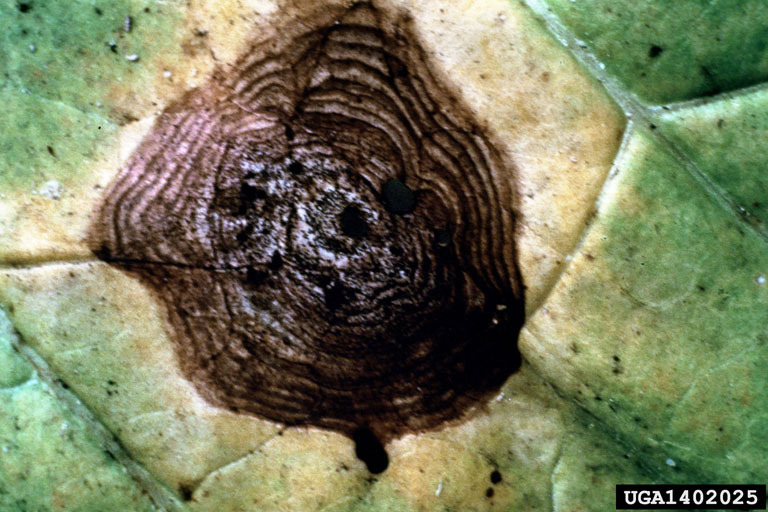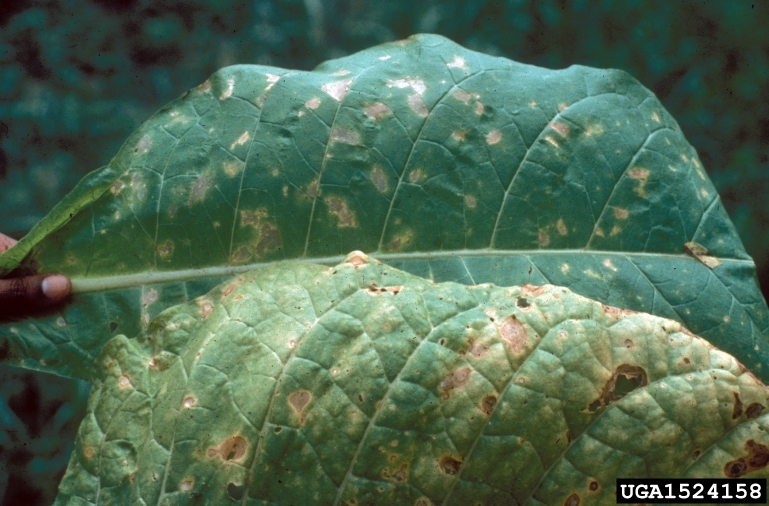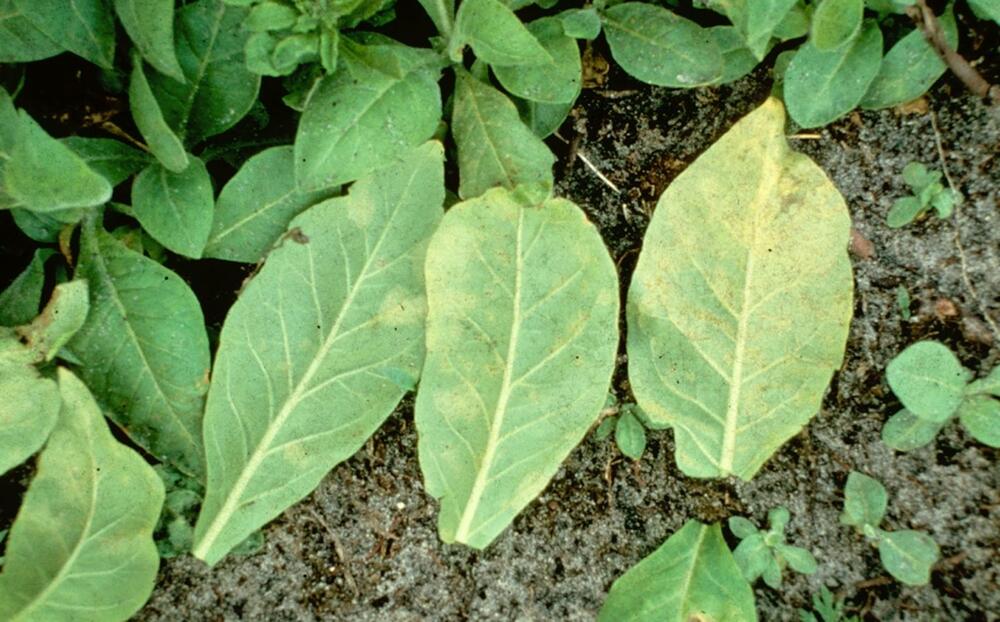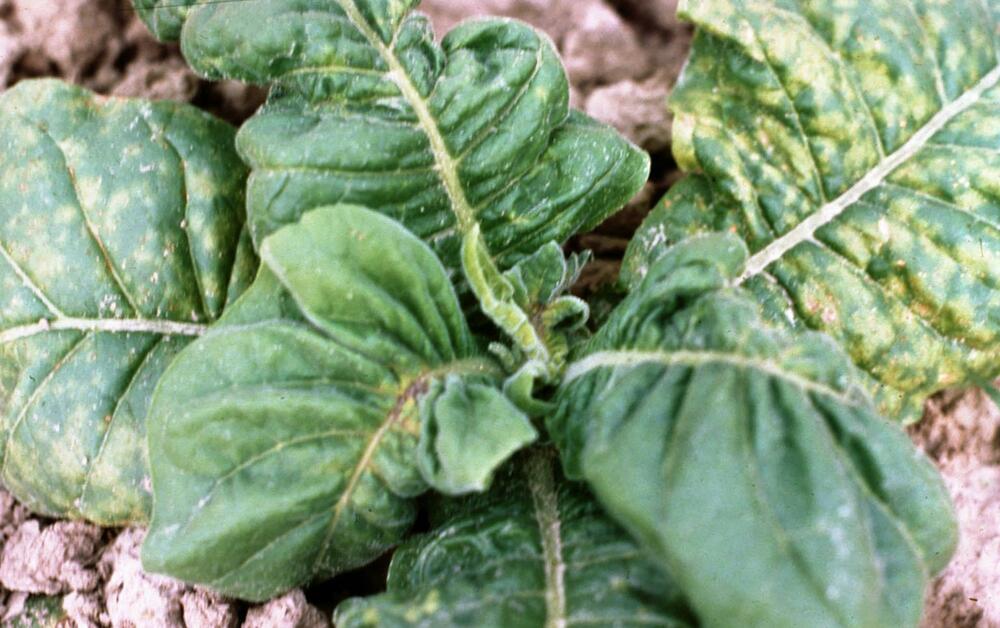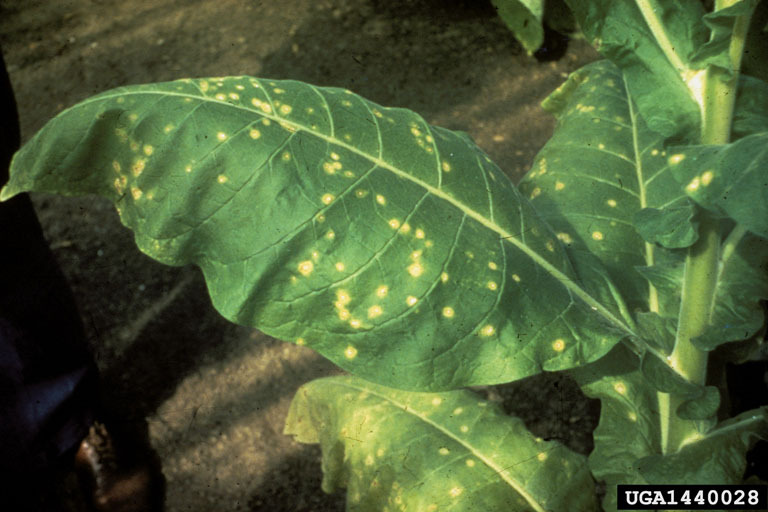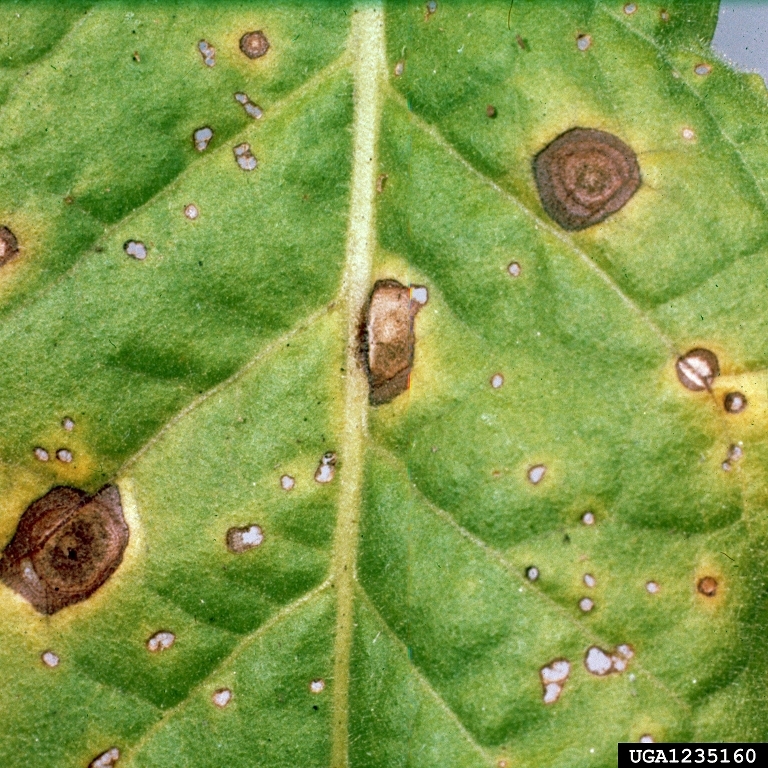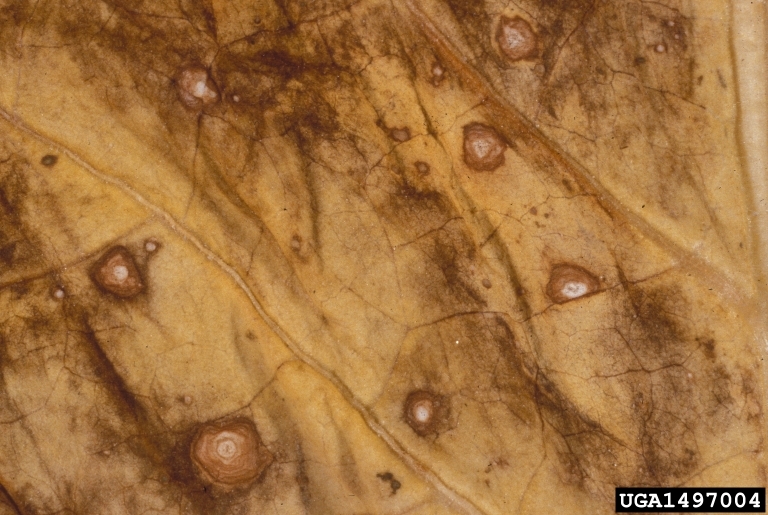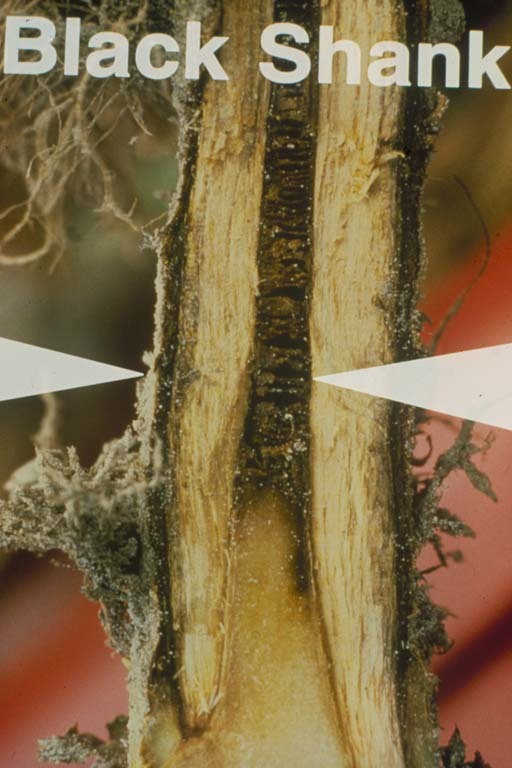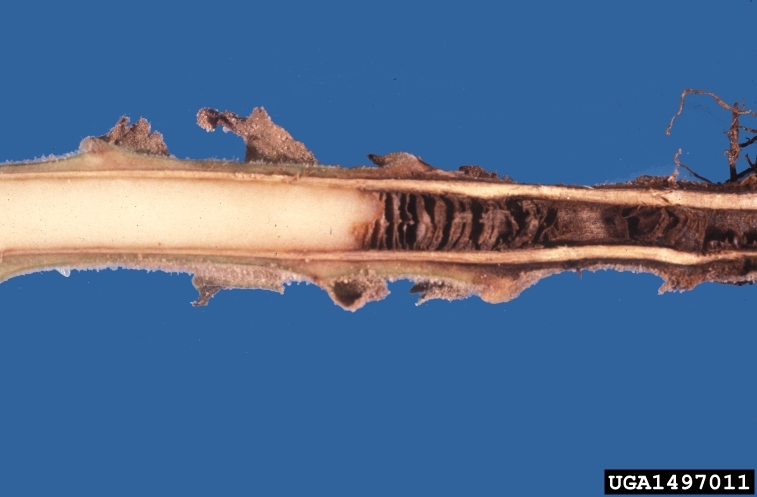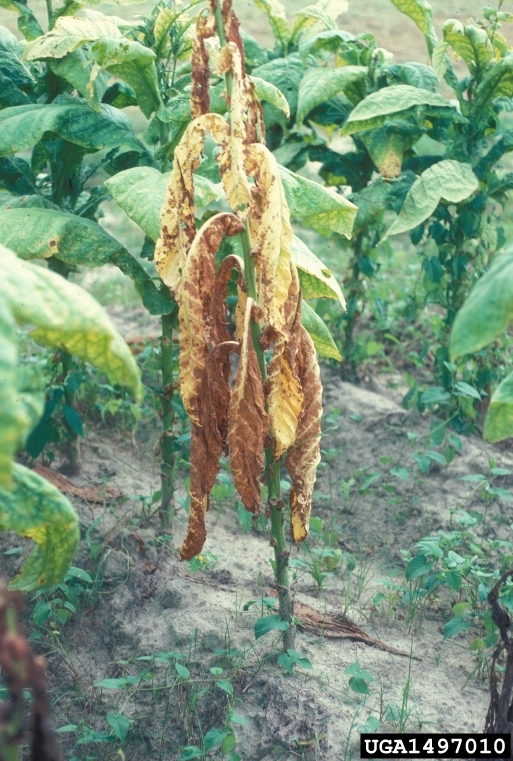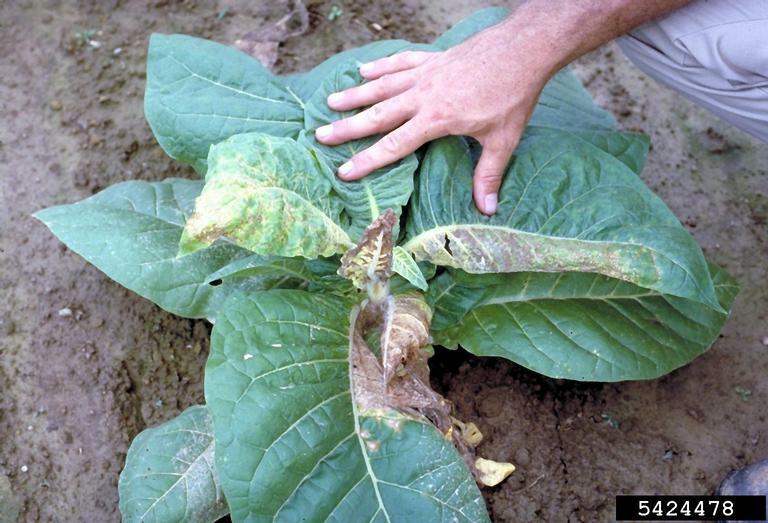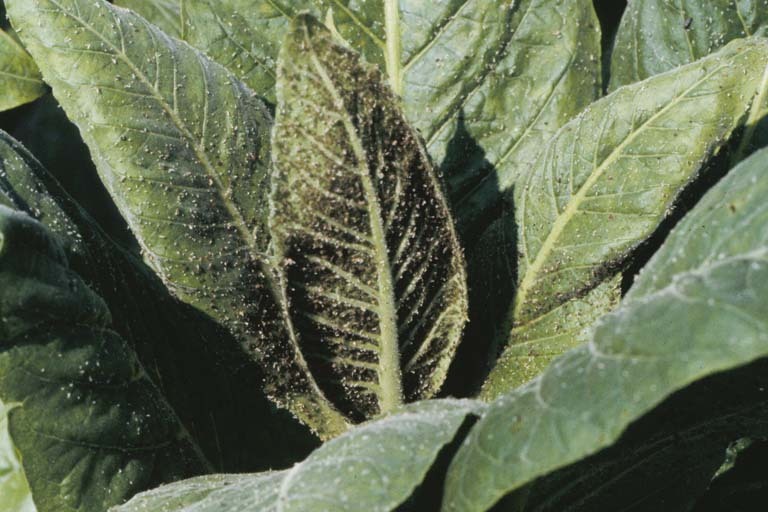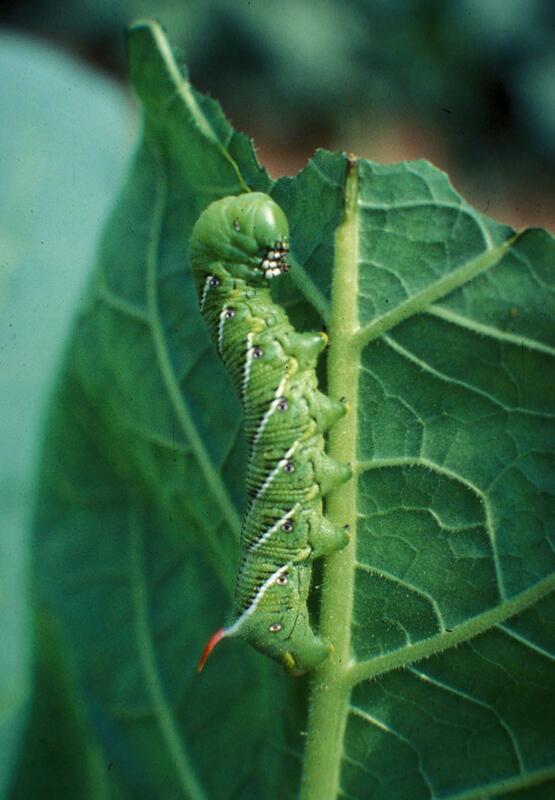Tobacco
Description
Uses
Propagation
References
Common Pests and Diseases
Diseases
Category : Fungal
Alternaria leaf spot (Brown spot) Alternaria alternata
Symptoms
Small, circular, target-like spots on lower leaves; lesions are usually surrounded by a bright yellow halo; lesions enlarge and coalesce; centers of lesions dry out and drop from leaf giving foliage a ragged appearance; if variety of tobacco being grown is susceptible to the disease then spots may also appear on stalks and suckers; if spots girdle stems then the plant may be killed.
Cause
Fungus
Comments
Disease emergence favors warm, wet weather; excessive fertilization can cause greater crop losses.
Management
Rotating crop away from tobacco can help to reduce the levels of inoculum in a field; stalks and roots left after harvest should be removed and destroyed; control nematodes in the soil; ensure plants have adequate potassium available to promote vigorous growth.Blue mold Peronospora tabacina
Symptoms
Circular patch of seedlings developing yellow leaves; seedlings in center may have leaves that have curled into a cup shape; fluffy blue spores developing on underside of leaves; distorted leaves; yellow lesions on leaves which may have blue mold growing on them.
Cause
Fungus
Comments
Disease emergence favors cool, wet conditions.
Management
Avoid over fertilizing tobacco crop and the use of overhead irrigation which created favorable conditions for the development of the fungus; applications of appropriate protective fungicides is usually necessary to control the disease in temperate and subtropical areas.Frogeye leaf spot Cercospora nicotianae
Symptoms
The pathogen infects all stages of crop (even after the leaves are harvested). Initially the lower leaves exhibit brown, round lesions which resembles frog-eye shape (generally of 2 -15 mm in diameter) with grayish center. The disease spreads upwards. Under favorable condition lesions may coalesce to become bigger lesions resulting in drying of leaves. Also we can see black dots (spores) in the centre of this lesions.
Cause
Fungus
Comments
The disease is favored by wet weather conditions. The pathogen is more prevalent in Taiwan, Nigeria, Pakistan, Central America and India.
Management
Remove and burn the infected leaves. Follow crop rotation. Keep the field free from weeds. Follow proper crop density. If the disease is severe apply suitable fungicides.Category : Oomycete
Black shank Phytophthora parasitica
Symptoms
Rapid yellowing and wilting of the plant proceeds plant death; dark brown to black sunken lesion is usually present on the stalk of the plant close to the soil line; lesion may extent up the stalk turning it black; splitting open stalks reveals darkened pith in discrete discs.
Cause
Oomycete
Comments
Disease emergence favors poorly drained soil and warm weather.
Management
Rotating the crop away from tobacco for at least one year will help to reduce levels of inoculum; plant tobacco varieties that have some degree of resistance to the disease; apply appropriate fungicides to the soil; plant tobacco in well draining soils; destroy stalks and roots immediately after harvest to reduce overwintering sites for the pathogen; control nematodes in the soil.Category : Other
Broomrape
Orobanche cernua
Orobanche ramosa
Symptoms
Broomrape is an complete root parasite which lacks chlorophyll and conspicuous leaves. Generally the weed shoots emerge near the tobacco plants in cluster and there roots were attached to tobacco roots to extract nutrients and water. The infested plants become weak, stunted with pale leaves. Eventually the whole plant may wilt.
Cause
Weed
Comments
It will cause 30 to 70% yield loss depends on severity of infestation. Broomrape also attacks on tomato, okra, eggplant etc.
Management
Deep summer ploughing helps in exposing weed seeds to sunlight and reduce weed population. Remove the emerged weeds before flowering and burn them (hand weeding). Rotating the crop with sorghum, black gram etc., to reduce weed population.Category : Fungal, Oomycete
Collar rot Sclerotinia sclerotiorum
Symptoms
Water-soaked, soft, green, lesion at base of stem; white mycelium present on lesion; black fungal structures developing out of the white fungal growth.
Cause
Fungus
Comments
Serious disease of glasshouse grown tobacco plants.
Management
Reduce build-up of moisture in glasshouses by increasing ventilation and air circulation; increase frequency of leaf clipping and reduce the amount of leaves removed at each clipping; avoid injury to seedlings.Category : Bacterial
Granville wilt Ralstonia solanacearum
Symptoms
Wilting on one side of the plant; entire plant begins to wilt and plant usually dies; if plant does not die then growth is usually stunted with twisted and distorted leaves; the stalk of the plant turns black, especially at the soil line.
Cause
Bacterium
Comments
The disease is most damaging in fields where tobacco has been grown the previous year and in wet areas of fields; bacterium can also colonize other Solanaceous crops such as tomato, pepper and eggplant as well as several weed species.
Management
One of the most important management strategies for Granville wilt is crop rotation as the bacteria that cause the disease do not survive well in the absence of the tobacco host plant; a rotation away from tobacco for as little as one year is highly beneficial; some tobacco varieties are more susceptible to the disease than others, although none are completely immune, and should be grown when the disease is of concern; all tobacco crop debris should be removed and destroyed following harvest to reduce inoculum levels.Category : Viral
Tobacco Leaf Curl disease
Tobacco Leaf Curl Virus (TLCV)
Begomovirus
Symptoms
The infected plants are stunted with twisted stem ; leaves become small, curled, twisted and puckered. The veins of infected leaves may become thickening or show enations.
Cause
Virus
Comments
The virus is transmitted by whiteflies Bemisia tabaci.
Management
Use available resistant varieties. Controlling the whiteflies will reduce the virus spread- use yellow sticky traps or cover the tobacco seedling /nursery with nylon nets or growing barrier crops (like sunflower etc.,) around the nursery may reduce the white fly population.Tobacco mosaic Tobacco mosaic virus (TMV)
Symptoms
Alternating light and dark green patches on the leaves; leaves turning brown and drying out.
Cause
Virus
Comments
Can be spread by farming equipment and on hand that have come into contact with cigarettes or other tobacco product; wash hands after tobacco use before touching plants.
Management
Plant resistant tobacco cariteies; remove and destroy any infected plants; disinfect tools thoroughly; wash hands thoroughly after use of tobacco products before handling plants; avoid having tobacco products on person when working with tobacco plants.
Tomato spotted wilt virus on Tobacco
Tomato Spotted Wilt Virus (TSWV)
Tospovirus
Symptoms
It infects all stage of tobacco plant. The infected young leaves may turn yellow then reddish brown; buds may become distorted and deformed. The mature leaves may develop concentric ring spots which later coalesce to form large areas of dead tissue . Some leaves shows yellowing and death of plant tissue along leaf veins. Stem may also show dark oblong concentric spots and lesions.
Cause
Virus
Comments
The virus attack wide variety of crops and is mainly transmitted by thrips.
Management
Remove the infected plant and burn them. Keep the field free from weeds. Spraying suitable insecticide to control thrips.Pests
Category : Insects
Aphids Myzus persicae
Symptoms
Small soft bodied insects on underside of leaves and/or stems of plant; usually green or yellow in color, but may be pink, brown, red or black depending on species and host plant; if aphid infestation is heavy it may cause leaves to yellow and/or distorted, necrotic spots on leaves and/or stunted shoots; aphids secrete a sticky, sugary substance called honeydew which encourages the growth of sooty mold on the plants.
Cause
Insect
Comments
Distinguishing features include the presence of cornicles (tubular structures) which project backwards from the body of the aphid; will generally not move very quickly when disturbed.
Management
If aphid population is limited to just a few leaves or shoots then the infestation can be pruned out to provide control; check transplants for aphids before planting; use tolerant varieties if available; reflective mulches such as silver colored plastic can deter aphids from feeding on plants; sturdy plants can be sprayed with a strong jet of water to knock aphids from leaves; insecticides are generally only required to treat aphids if the infestation is very high - plants generally tolerate low and medium level infestation; insecticidal soaps or oils such as neem or canola oil are usually the best method of control; always check the labels of the products for specific usage guidelines prior to use.
Horworms (Tobacco hornworm, Tomato hornworm)
Manduca quinquemaculata
Manduca sexta
Symptoms
Feeding damage to leaves or leaves stripped from plant; heavy infestation may result in damage to fruit appearing as large open scars; large green caterpillars may be spotted on plant; caterpillars may reach in excess of 7.5 cm (3 in) in length and possess a spike at the end of their body; most common species have 7 diagonal stripes on sides or 8 v-shaped markings on each side; single eggs may be present on leaves and measure approx 1.3 mm in diameter; eggs are in initially light green in color and turn white prior to hatching.
Cause
Insect
Comments
Insect overwinters as pupa in soil; typically undergoes 2 generations per year; heavy infestations are more common in warm areas.
Management
Hand pick larvae from plants leaving any parasitized larvae behind to promote populations of natural enemies (these larvae can be distinguished by the presence of white, oblong-shaped cocoons on their backs); sprays of Bacillus thuringiensis are organically acceptable and highly effective.
Loopers (Cabbage looper, Alfalfa looper)
Trichoplusia ni
Autographa californica
Symptoms
Large or small holes in leaves; damage often extensive; caterpillars are pale green with a white lines running down either side of their body; caterpillars are easily distinguished by the way they arch their body when moving; eggs are laid singly, usually on the lower leaf surface close to the leaf margin, and are white or pale green in color.
Cause
Insect
Comments
Insects overwinter as pupae in crop debris in soil; adult insect id a dark colored moth; caterpillars have a wide host range.







